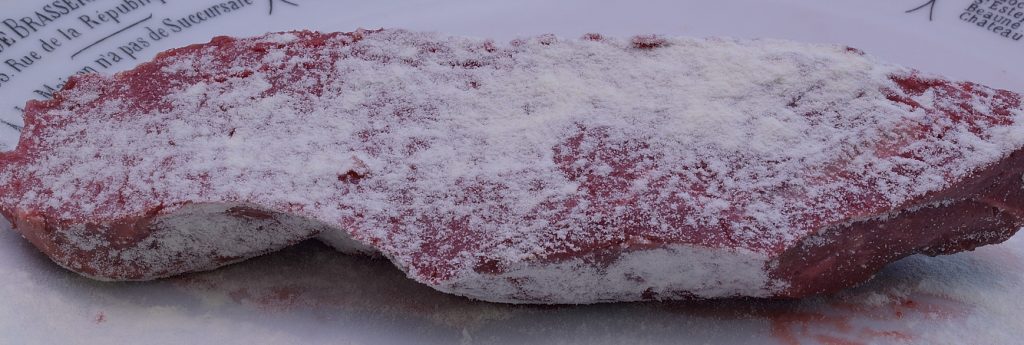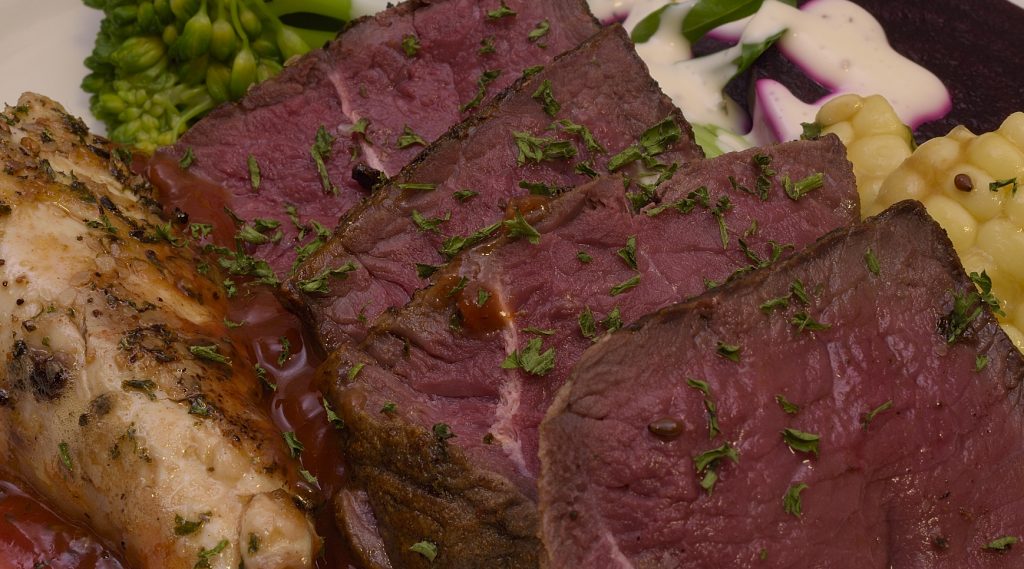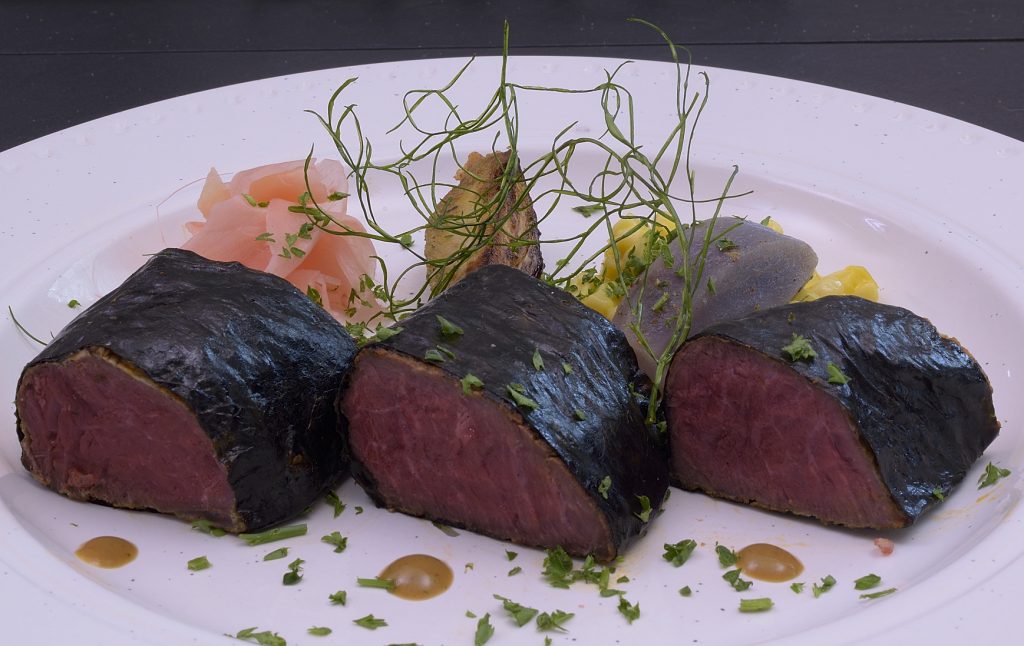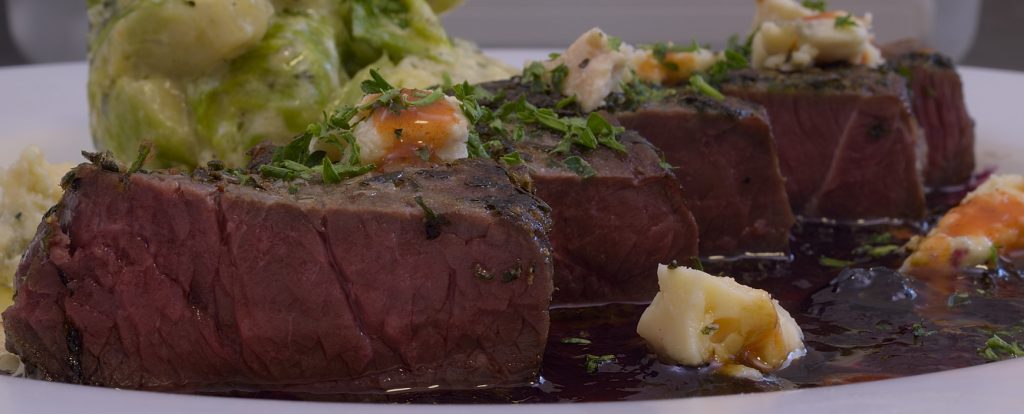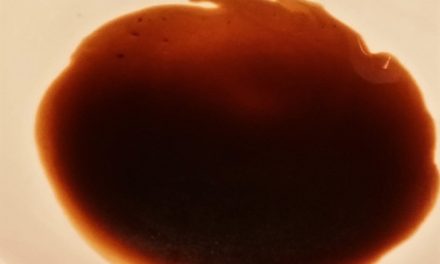Terms of en-deer-ment…
Where do you get elk? Admittedly, you are unlikely to see elk or deer venison in the butcher’s case at the local chain grocery store. Avid hunters notwithstanding, most of us have never seen it, much less eaten it. Wholesale meat brokers have access and carry it if there are restaurants who want to serve it. People are surprised to discover that many brokers will gladly sell to the public at large. You may have to commit yourself to a minimum purchase of $200 or so to make it worth their while. It almost always comes frozen.

Raw, defrosted, 2.2 lbs./1 Kg. You can see that the meat is considerably darker than beef and quite a bit leaner. Beef top sirloin is generally considered “moderately tender” and benefits from a certain amount of sous vide tenderization. My experience has taught me that elk must not be very active in their daily routine. Other than cuts like shanks and tongue, they are generally more tender than beef. One way or the other, we can measure tenderness of any cut, any species in real time using the pinch/poke method.
Processing

Preheat the sous vide bath to 129 F/54 C. Vacuum seal the entire roast in a heat rated bag and process for 8 hours. This will pasteurize/preserve the cut and create a uniformly rare appearance without tenderizing the meat excessively. Submerge the package in iced water until it achieves 70 F/21 C and refrigerate at 40 F/4 C until day of service. In this state, the roast will keep safely for at least two weeks without any degradation of quality or appearance.
Note: the roast can also be pre-cut into smaller portions before processing. This will not alter the temperature or time requirements, although pasteurization will occur somewhat sooner as per on the graph shown HERE.
Day of Service

40 F/4 C, sealed. 
Remove from packaging, pat dry, reserve juices for clarification.
Once processed, the roast can be utilized for any of a number of applications. Since we did not (nor do we rarely) include seasonings or even salt in the bag, we will create a surface flavoring that can endure contact with a hot surface. I recommend setting an oven at 145 F/63 C (“warm”)–this is great for heating plates in advance and for keeping different components of your meal warm while you assemble you masterpiece!


Preheat a skillet to 350 F/176 C. Note: Infrared thermometers are inexpensive and are excellent devices to measure the temperature of the pan. Put a few drops of oil in the pan to help the thermometer gauge accurately. Use a paper towel to wipe out the pan before continuing.

Stage the steak into the pan and add 1-2 Tablespoons of oil to prevent scorching. Brown each surface of the steak(s), (one at a time) and place in the preheated warming oven. This will finish the process of achieving an internal temperature of at least 125 F/53 C and give you time to put the finishing touches on your creation as we mentioned before.
Presentations
“London Broil” style.
Ranch dressing, and ketchup, yes, ketchup. There is no more shame in using ketchup than there is in using Tabasco, Buffalo wing sauce, demi-glace or any other sauce or condiment. Eat what you like!
Faux Tataki style
Sous vide corn tossed in a creamy emulsion with mango puree. Peruvian purple potatoes are available in most markets, usually bagged with assorted “fingerling” potatoes. Sous vide processed at 183 F/84 C for about 30 minutes, shocked cold, and tossed with melted butter. The fennel frond was deep fried to create the crisp effect. The droplets of sauce are a Ginger Tamarind.
Steakhouse Style #1
Cooking spinach can be troublesome because of all the water it releases and its tendency to discolor. An old Greek lady taught me to “cure” the spinach by soaking it in salt water brine–(1 Tablespoon of salt per cup of water) until it softens, usually an hour or two. Drain well. I “sous vide-ized” the method by wrapping the spinach in a towel and vacuuming in a plastic bag–no cook. This will keep in the refrigerator for at least a week. At service, unwrap and sauté lightly in a pan only until hot.
Again, the mango creamed corn described in the Tataki recipe above. Imported Roquefort cheese, a little goes a long way. Assorted sauces to include glace de viande and Catalina.
Steakhouse Style #2
This version is similar to #1 in that it utilizes the imported Roquefort cheese. The sauce is the same glace de viande with some fresh Oregon blueberries simmered into it. Blanched Brussels sprouts (not sous vide), shocked cold, and then simmered in equal amounts butter and whipping cream to create a thick emulsion. The mixture is loaded into a cylindrical frame on the plate which is then removed to create the shape.
Parsley. Always parsley.


